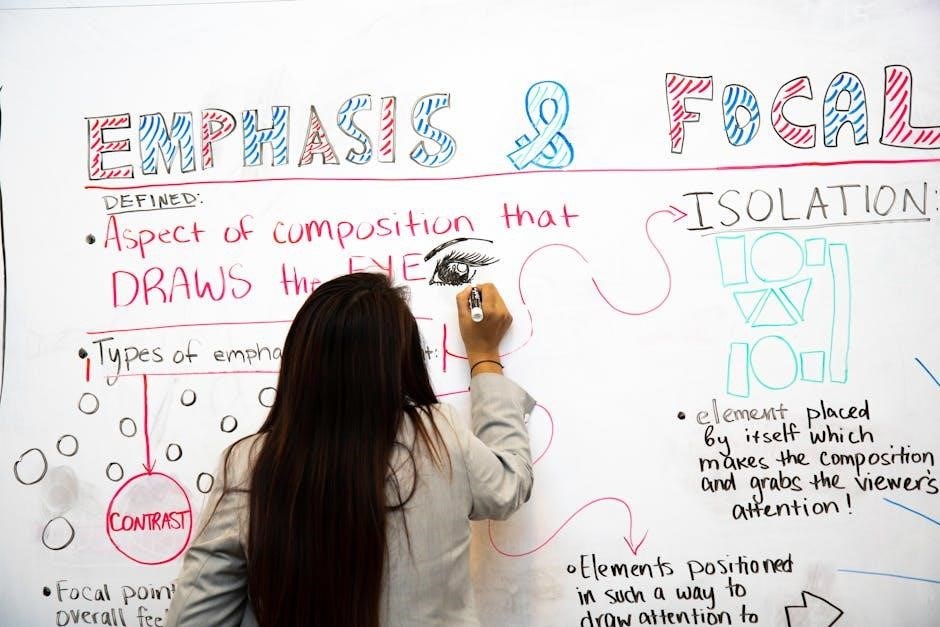Narrative writing is a creative process that engages students in storytelling, focusing on characters, setting, and plot. This introduction sets the stage for exploring key elements and techniques to craft compelling stories, encouraging students to express their imagination and develop essential writing skills through structured activities and interactive exercises.
Objective of the Lesson Plan
The objective of this lesson plan is to introduce students to the fundamental elements of narrative writing, enabling them to craft engaging stories. Students will learn to identify key components such as character development, setting, and plot structure. Through guided practice and interactive activities, they will develop their writing skills, fostering creativity and critical thinking. The lesson aims to build confidence in storytelling and provide a foundation for advanced narrative techniques.
Materials Needed for the Lesson
Essential materials include whiteboards, markers, printed story elements worksheets, and writing paper. Students will also need access to sample narratives, online writing tools, and dictionaries. Additionally, a projector and computer are recommended for displaying examples and guiding activities. These resources will support interactive learning, creative writing, and effective skill development throughout the lesson.
Hook Activity to Engage Students

Key Features of Narrative Writing
Narrative writing involves plotting, character development, and descriptive language to convey themes and emotions. It often includes dialogue, conflict, and resolution, engaging readers through storytelling techniques and vivid imagery to create immersive experiences.
Understanding Story Elements
Story elements, such as plot, characters, and setting, are essential for crafting engaging narratives. Plot refers to the sequence of events driving the story forward, while characters are the individuals whose actions and emotions shape the narrative. Setting establishes the time and place, creating context. These elements work together to build suspense, convey themes, and connect with readers. Understanding and identifying these components helps students analyze and create meaningful stories effectively in their writing;
Importance of Character Development
Character development is crucial in narrative writing as it brings depth and relatability to stories. Well-crafted characters with distinct traits, motivations, and growth engage readers emotionally. Through dialogue, actions, and interactions, characters reveal their personalities, making the story more immersive. Effective character development helps convey themes and emotions, allowing students to create memorable and impactful narratives that resonate with their audience.
Role of Setting in Narratives
The setting in a narrative establishes the time and place of the story, creating a backdrop that influences characters and events. A well-crafted setting helps readers visualize the environment, immerse themselves in the story, and understand the context for events. It also shapes the mood and atmosphere, contributing to the overall tone of the narrative. Effective use of setting enhances the believability and engagement of the story, making it a vital element in narrative writing.

Lesson Plan Activities
Engaging activities include reading sample narratives, guided writing practice, and independent exercises. These tasks promote storytelling skills, creativity, and understanding of narrative structure through hands-on learning.
Reading and Analyzing Sample Narratives
Students will engage in reading and analyzing sample narratives to identify key story elements, such as characters, setting, and plot. Guided discussions will focus on understanding how authors use descriptive language and dialogue to convey themes. This activity helps students recognize narrative structure and techniques, fostering a deeper appreciation for storytelling and providing a foundation for their own writing. It encourages critical thinking and active participation in the learning process.
Guided Practice in Writing
During guided practice, students will work in small groups or pairs to craft short narrative passages. The teacher will circulate to provide individualized feedback, ensuring students apply learned story elements. This collaborative environment encourages peer support and refinement of ideas, helping students build confidence and improve their writing skills through structured guidance and immediate feedback.
Independent Writing Exercise
The independent writing exercise allows students to apply the skills learned during guided practice. They will write their own short narratives individually, brainstorming ideas, developing characters, and organizing plot elements. The teacher will be available for support but encourages students to work autonomously. This activity helps students refine their writing skills, express creativity, and build confidence in crafting original stories independently.

Assessment and Evaluation
Assessment involves evaluating student narratives using clear criteria, focusing on creativity, coherence, and use of story elements. Peer reviews and self-assessment tools help students reflect on their work and identify areas for improvement, fostering a growth mindset and enhancing their writing skills effectively through constructive feedback.
Criteria for Grading Narratives
Grading narratives involves assessing creativity, coherence, and adherence to story elements. Criteria include character development, plot structure, descriptive language, and emotional engagement. Students are evaluated on their ability to convey a clear theme and maintain a logical flow. Rubrics are provided to ensure transparency, with specific points allocated to each element. This structured approach helps students understand expectations and improve their writing effectively.
Peer Review and Feedback
Peer review and feedback are essential for improving narrative writing. Students exchange their drafts, providing constructive comments on character development, plot coherence, and emotional impact. Guided by specific questions, they learn to identify strengths and areas for improvement. This collaborative process fosters critical thinking, enhances writing quality, and builds confidence in sharing their work.
Self-Assessment Techniques
Self-assessment techniques empower students to evaluate their own narrative writing. Using checklists or rubrics, students identify strengths and areas for improvement. This fosters ownership of learning, allowing them to reflect on progress and set goals. Guided reflection activities help students analyze their narratives, enhancing critical thinking and confidence. Regular self-assessment promotes growth and independence in writing, preparing students for future challenges in creative and academic contexts.

Differentiation and Support
Differentiation and support ensure all learners thrive in narrative writing. Strategies include scaffolding, groupwork, and tailored resources to meet diverse needs, fostering inclusive and effective learning environments.
Strategies for Diverse Learners
Strategies for diverse learners include scaffolding techniques, visual aids, and group collaboration to cater to varying needs. Teachers can provide tiered assignments or graphic organizers to support struggling writers, while advanced learners may explore complex narratives or creative writing extensions. Additionally, incorporating technology, such as writing apps, can engage digital learners and accommodate different learning styles, fostering an inclusive classroom environment that promotes creativity and growth for all students.
Additional Resources for Students
Additional resources include narrative writing workbooks, online tools like writing apps, and interactive websites. Students can access sample PDF lesson plans, mentor texts, and video tutorials to enhance their skills. Graphic organizers and writing checklists are also provided to guide the writing process. These resources cater to diverse learning needs, offering support and enrichment opportunities to help students refine their narrative writing abilities effectively and creatively.
Scaffolding Techniques for Complex Tasks
Scaffolding involves breaking tasks into manageable steps, providing models, and offering guided support. Teachers can use graphic organizers to plan narratives, provide sentence starters, and model writing processes. Students benefit from gradual release of responsibility, moving from joint to independent writing. These techniques ensure all learners, especially struggling ones, can access and succeed in complex narrative writing tasks with confidence and clarity.

Homework and Follow-Up
Assign students a short narrative writing exercise, review a sample story, and reflect on their progress. Encourage sharing work in the next class for feedback.
Assignments to Reinforce Learning
Assign students to read a sample narrative and analyze its story elements, such as characters, plot, and setting. Create a worksheet for identifying these elements and provide a writing checklist. Encourage students to write a short personal narrative using the checklist as a guide. Additionally, assign a peer review session where students exchange their work and offer constructive feedback. This reinforces learning and improves writing skills through practical application.
Next Steps in Narrative Writing
After mastering the basics, students can explore advanced techniques like varying narrative perspectives and incorporating descriptive language. Introduce complex themes such as flashbacks or parallel storylines. Assign creative prompts that encourage students to write from different characters’ viewpoints. Provide resources like writing guides or online tools to support continued development. Encourage students to revise and refine their work for a final portfolio or class anthology, fostering a sense of accomplishment and growth.
Sharing Student Work
Sharing student work fosters a sense of community and pride in their creations. Encourage students to read their narratives aloud in class or publish them in a class anthology. Create an online platform or blog for students to share their work with a broader audience. Pair sharing with peer discussions to promote constructive feedback and mutual learning. This step celebrates their progress and builds confidence in their writing abilities.
This lesson plan on narrative writing equips students with essential storytelling skills, fostering creativity and critical thinking. Through engaging activities and assessments, students gain confidence in crafting compelling narratives, preparing them for future writing challenges. Reflecting on their progress, they develop a deeper appreciation for the power of storytelling in communication and self-expression.
Summarizing Key Takeaways
Narrative writing focuses on storytelling, incorporating elements like setting, characters, and plot. Students learn to structure stories, develop characters, and use descriptive language. The lesson emphasizes creativity, critical thinking, and effective communication. By analyzing examples and engaging in writing exercises, students gain confidence in expressing their ideas. Reflecting on their work helps them identify strengths and areas for improvement, fostering growth as writers. This approach prepares students for more complex writing tasks and enhances their overall literacy skills.
Reflecting on the Learning Process
Reflecting on the learning process helps students evaluate their progress in narrative writing. By analyzing their work, they identify strengths and areas needing improvement. Peer feedback and self-assessment tools encourage critical thinking and personal growth. This reflection fosters a deeper understanding of storytelling elements and enhances their ability to convey ideas effectively. It also guides them in setting future writing goals and applying feedback to refine their craft.
Setting Future Goals for Writing
Setting future goals for writing encourages students to build on their narrative skills. They can aim to expand creativity, refine character development, and explore diverse narrative styles. By identifying areas for improvement, students create actionable plans to enhance their writing. This process fosters a growth mindset, enabling them to approach challenges with confidence and continue refining their craft in upcoming writing projects and beyond.

Additional Resources

Explore workbooks, online tools, and sample PDFs to enhance narrative writing instruction. These resources provide structured activities and examples to support teachers in creating engaging lesson plans year-round.

Recommended Reading Materials
Enhance your teaching with workbooks offering creative writing exercises, online tools featuring interactive examples, and sample PDFs providing structured lesson plans. Mentor texts like “The A from Miss Keller” and graphic organizers can inspire students. Additionally, Scholastic resources and educational blogs provide valuable insights and activities to support narrative writing instruction, ensuring a well-rounded approach to teaching this essential skill.
Online Tools for Writing Practice
Utilize online platforms like “Storybird” for visual storytelling, “WriteAbout” for interactive writing prompts, and “Grammarly” for real-time feedback. These tools enhance creativity, organization, and grammar skills. Additionally, educational websites offer narrative writing exercises, quizzes, and templates to support students in developing their writing abilities effectively. These resources provide interactive and engaging ways to practice narrative writing skills.
Sample PDF Lesson Plans
Downloadable PDF lesson plans provide structured templates for teaching narrative writing. These plans include detailed objectives, activities, and assessments. Resources like “Narrative Writing Lesson Plan” by EA Danilova offer step-by-step guides, while educational websites provide customizable templates. These PDFs are ideal for teachers seeking organized, printable materials to effectively deliver narrative writing instruction and ensure comprehensive student understanding of storytelling techniques.
